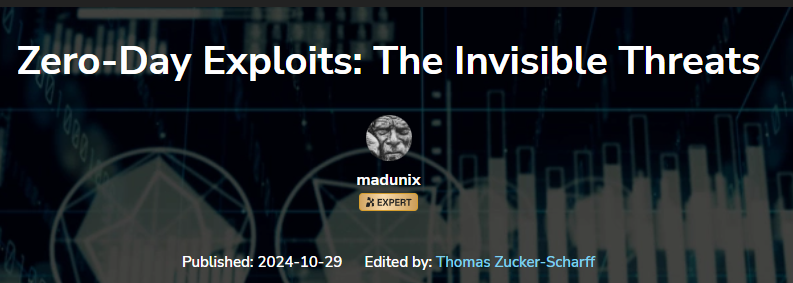Zero-Day Exploits: The Invisible Threats by Fadi Sodah (madunix)
Original article by: Fadi Sodah (madunix)
Summary:
Zero-Day exploits pose serious risks to IT systems, as they target unknown vulnerabilities before developers can patch them. Here’s an overview of their lifecycle, key statistics, and prevention strategies.
Key Takeaways 🔐:
Summary:
Zero-Day exploits pose serious risks to IT systems, as they target unknown vulnerabilities before developers can patch them. Here’s an overview of their lifecycle, key statistics, and prevention strategies.
Key Takeaways 🔐:
➡ Definition and Risks: Zero-Days are security flaws unknown to developers and the public. Attackers exploit them without interference, making these threats highly dangerous and difficult to prevent. Zero-Day vulnerabilities can compromise data, disrupt operations, and cause financial losses.
➡ Lifecycle of an Exploit: The Zero-Day lifecycle starts when a software version is released. Hackers probe for vulnerabilities and exploit any found weaknesses until they are publicly disclosed or patched.
➡ Key stages include:
1. Uploading Software: New software version is released.
2. Public Access: Software becomes available for download.
3. Probing for Vulnerabilities: Hackers search for hidden flaws.
4. Exploitation: Attackers exploit found flaws for unauthorized access.
5. Disclosure: The vulnerability is publicly identified.
6. Patching: Developers release patches to fix the issue.
➡ Market for Vulnerabilities: Zero-Day information is valuable. Platforms like Zerodium buy and sell vulnerabilities, offering significant rewards. These markets show the competitive nature of Zero-Day discovery.
➡ Notable Examples: Cases like the Stuxnet worm, which targeted Iran’s nuclear program using four Zero-Day vulnerabilities, and the Log4Shell flaw highlight the complex and damaging nature of these attacks.
➡ Statistics on Zero-Day Threats: In 2023, Google’s Project Zero identified 56 Zero-Day vulnerabilities exploited in attacks. Around 40% of the 141 actively exploited vulnerabilities on the CVE list were used as Zero-Days before disclosure.
➡ Mitigation Strategies: Key strategies include continuous patch management, sandboxing, secure coding practices, regular security assessments, and user education. AI and machine learning can aid in anomaly detection and proactive defense.
➡ Importance of an Incident Response Plan (IRP): An updated IRP is essential for rapid response and recovery. It should outline clear protocols, designate responsible personnel, and include communication strategies.
Zero-Days aren’t going away anytime soon. Staying vigilant with comprehensive security measures, fostering collaboration, and leveraging advanced technologies are crucial to defend against these threats.
Organizations must remain proactive, adapt to evolving threats, and build resilience.
Equip yourself with the knowledge to defend against evolving Zero-Day threats. The AKYLADE Certified Cyber Resilience Fundamentals (A/CCRF) and Certified Cyber Resilience Practitioner (A/CCRP) certifications empower you with strategies to build resilient, threat-resistant systems. Strengthen your defenses and join the professionals embracing resilience-first cybersecurity. Learn more at AKYLADE.
For the full article, visit: https://www.experts-exchange.com/articles/39277/Zero-Day-Exploits-The-Invisible-Threats.html

#CyberSecurity #ZeroDay #IncidentResponse #ITSecurity #CyberThreats
Topic Participants
Alyson Laderman